A Sensitive Immunodetection Assay Using Antibodies Specific to Staphylococcal Enterotoxin B Produced by Baculovirus Expression
Abstract
1. Introduction
2. Materials and Methods
2.1. Cell Lines
2.2. Construction of SEB-Encoding Bacmid
2.3. Generation and Titration of SEB-Encoding Baculovirus
2.4. Production of Recombinant SEB
2.5. SDS–PAGE and Immunoblotting
2.6. LC-MS/MS Analysis and Peptide Mapping
2.7. Hybridoma Generation, mAb Sequence Analysis, and mAb Production
2.8. Direct ELISA
2.9. BLI Analysis
2.10. Competitive ELISA
2.11. Sandwich ELISA
2.12. Theoretical LoD
2.13. Antibody Modeling and Docking Analysis
2.14. Natural SEB Detection
3. Results
3.1. Preparation of Baculovirus Encoding Recombinant SEB Gene
3.2. High Expression and Purity of SEB Produced Using BEVS
3.3. Characterization of Recombinant SEB
3.4. Generation and Characterization of mAbs Directed against SEB
3.5. Development of a Sensitive Sandwich ELISA-Based Immunodetection Assay for the Detection of SEB
3.6. Sensitive Detection of Recombinant and Natural SEB by 2-8G and 11-7E mAbs
3.7. Structural Modeling Reveals That mAbs Specifically Bind to Super-Antigenic SEB
4. Discussion
5. Conclusions
Supplementary Materials
Author Contributions
Funding
Institutional Review Board Statement
Informed Consent Statement
Data Availability Statement
Acknowledgments
Conflicts of Interest
References
- Liu, G.Y. Molecular pathogenesis of Staphylococcus aureus infection. Pediatr. Res. 2009, 65, 71R–77R. [Google Scholar] [CrossRef] [PubMed]
- Bien, J.; Sokolova, O.; Bozko, P. Characterization of virulence factors of Staphylococcus aureus: Novel function of known virulence factors that are implicated inactivation of airway epithelial proinflammatory response. J. Pathog. 2011, 2011, 601905. [Google Scholar] [CrossRef] [PubMed]
- Pinchuk, I.V.; Beswick, E.J.; Reyes, V.E. Staphylococcal enterotoxins. Toxins 2010, 2, 2177–2197. [Google Scholar] [CrossRef] [PubMed]
- Benkerroum, N. Staphylococcal enterotoxins and enterotoxin-like toxins with special reference to dairy products: An overview. Crit. Rev. Food Sci. Nutr. 2018, 58, 1943–1970. [Google Scholar] [CrossRef]
- Proft, T.; Fraser, J.D. Bacterial superantigens. Clin. Exp. Immunol. 2003, 133, 299–306. [Google Scholar] [CrossRef] [PubMed]
- Tuffs, S.W.; Goncheva, M.I.; Xu, S.X.; Craig, H.C.; Kasper, K.J.; Choi, J.; Flannagan, R.S.; Kerfoot, S.M.; Heinrichs, D.E.; McCormick, J.K. Superantigens promote Staphylococcus aureus bloodstream infection by eliciting pathogenic interferon-gamma production. Proc. Natl. Acad. Sci. USA 2022, 119, e2115987119. [Google Scholar] [CrossRef] [PubMed]
- Gill, D.M. Bacterial toxins: A table of lethal amounts. Microbiol. Rev. 1982, 46, 86–94. [Google Scholar] [CrossRef]
- Ferguson, J.R. Biological weapons and US law. JAMA 1997, 278, 357–360. [Google Scholar] [CrossRef] [PubMed]
- Rosenbloom, M.; Leikin, J.B.; Vogel, S.N.; Chaudry, Z.A. Biological and chemical agents: A brief synopsis. Am. J. Ther. 2002, 9, 5–14. [Google Scholar] [CrossRef] [PubMed]
- Wu, S.; Duan, N.; Gu, H.; Hao, L.; Ye, H.; Gong, W.; Wang, Z. A review of the methods for detection of Staphylococcus aureus enterotoxins. Toxins 2016, 8, 176. [Google Scholar] [CrossRef] [PubMed]
- Callahan, J.H.; Shefcheck, K.J.; Williams, T.L.; Musser, S.M. Detection, confirmation, and quantification of staphylococcal enterotoxin B in food matrixes using liquid chromatography--mass spectrometry. Anal. Chem. 2006, 78, 1789–1800. [Google Scholar] [CrossRef] [PubMed]
- Lefebvre, D.; Blanco-Valle, K.; Hennekinne, J.A.; Simon, S.; Fenaille, F.; Becher, F.; Nia, Y. Multiplex detection of 24 Staphylococcal Enterotoxins in culture supernatant using liquid chromatography coupled to high-resolution mass spectrometry. Toxins 2022, 14, 249. [Google Scholar] [CrossRef] [PubMed]
- Soelberg, S.D.; Stevens, R.C.; Limaye, A.P.; Furlong, C.E. Surface plasmon resonance detection using antibody-linked magnetic nanoparticles for analyte capture, purification, concentration, and signal amplification. Anal. Chem. 2009, 81, 2357–2363. [Google Scholar] [CrossRef] [PubMed]
- Yang, M.; Bruck, H.A.; Kostov, Y.; Rasooly, A. Biological semiconductor based on electrical percolation. Anal. Chem. 2010, 82, 3567–3572. [Google Scholar] [CrossRef] [PubMed][Green Version]
- Maraldo, D.; Mutharasan, R. Detection and confirmation of staphylococcal enterotoxin B in apple juice and milk using piezoelectric-excited millimeter-sized cantilever sensors at 2.5 fg/mL. Anal. Chem. 2007, 79, 7636–7643. [Google Scholar] [CrossRef] [PubMed]
- Loir, L.Y.; Hennekinne, J.-A. Detection of staphylococcal enterotoxins. In Encyclopedia of Food Microbiology, 2nd ed.; Batt, C.A., Tortorello, M.-L., Eds.; Academic Press: Cambridge, MA, USA, 2018; Volume 3, pp. 494–500. [Google Scholar]
- Abril, A.G.; Villa, T.A.; Barros-Velazquez, J.; Canas, B.; Sanchez-Perez, A.; Calo-Mata, P.; Carrera, M. Staphylococcus aureus exotoxins and their detection in the dairy industry and mastitis. Toxins 2020, 12, 537. [Google Scholar] [CrossRef] [PubMed]
- Schantz, E.J.; Roessler, W.G.; Wagman, J.; Spero, L.; Dunnery, D.A.; Bergdoll, M.S. Purification of staphylococcal enterotoxin B. Biochemistry 1965, 4, 1011–1016. [Google Scholar] [CrossRef]
- Dainiak, M.; Hedstrom, M.; Galaev, I.Y.; Mattiasson, B. Improved methods for prepurification and detection of staphylococcal enterotoxin B from cell-free culture filtrate. Biotechnol. Prog. 2005, 21, 1347–1351. [Google Scholar] [CrossRef]
- Balaban, N.; Rasooly, A. Analytical chromatography for recovery of small amounts of staphylococcal enterotoxins from food. Int. J. Food Microbiol. 2001, 64, 33–40. [Google Scholar] [CrossRef]
- Kohler, P.L.; Greenwood, S.D.; Nookala, S.; Kotb, M.; Kranz, D.M.; Schlievert, P.M. Staphylococcus aureus isolates encode variant staphylococcal enterotoxin B proteins that are diverse in superantigenicity and lethality. PLoS ONE 2012, 7, e41157. [Google Scholar] [CrossRef]
- Coffman, J.D.; Zhu, J.; Roach, J.M.; Bavari, S.; Ulrich, R.G.; Giardina, S.L. Production and purification of a recombinant Staphylococcal enterotoxin B vaccine candidate expressed in Escherichia coli. Protein Expr. Purif. 2002, 24, 302–312. [Google Scholar] [CrossRef]
- Zhang, L.; Rogers, T.J. Assessment of the functional regions of the superantigen staphylococcal enterotoxin B. Toxins 2013, 5, 1859–1871. [Google Scholar] [CrossRef]
- Vrat Kamboj, D.; Nema, V.; Kumar Pandey, A.; Kumar Goel, A.; Singh, L. Heterologous expression of staphylococcal enterotoxin B (seb) gene for antibody production. Electron. J. Biotechnol. 2006, 9, 5. [Google Scholar] [CrossRef][Green Version]
- Agrawal, R.; Singh, P.K.; Sharma, S.K.; Kamboj, D.V.; Goel, A.K.; Singh, L. Highly expressed recombinant SEB for antibody production and development of immunodetection system. Indian J. Microbiol. 2012, 52, 191–196. [Google Scholar] [CrossRef][Green Version]
- Kost, T.A.; Condreay, J.P.; Jarvis, D.L. Baculovirus as versatile vectors for protein expression in insect and mammalian cells. Nat. Biotechnol. 2005, 23, 567–575. [Google Scholar] [CrossRef] [PubMed]
- Contreras-Gomez, A.; Sanchez-Miron, A.; Garcia-Camacho, F.; Molina-Grima, E.; Chisti, Y. Protein production using the baculovirus-insect cell expression system. Biotechnol. Prog. 2014, 30, 1–18. [Google Scholar] [CrossRef]
- Adeniyi, A.A.; Lua, L.H. Protein expression in the baculovirus-insect cell expression system. Methods Mol. Biol. 2020, 2073, 17–37. [Google Scholar] [CrossRef] [PubMed]
- Victor, M.E.; Bengtsson, A.; Andersen, G.; Bengtsson, D.; Lusingu, J.P.; Vestergaard, L.S.; Arnot, D.E.; Theander, T.G.; Joergensen, L.; Jensen, A.T. Insect cells are superior to Escherichia coli in producing malaria proteins inducing IgG targeting PfEMP1 on infected erythrocytes. Malar. J. 2010, 9, 325. [Google Scholar] [CrossRef]
- Laakkonen, P.; Hyvonen, M.; Peranen, J.; Kaariainen, L. Expression of Semliki Forest virus nsP1-specific methyltransferase in insect cells and in Escherichia coli. J. Virol. 1994, 68, 7418–7425. [Google Scholar] [CrossRef] [PubMed]
- Markova, S.V.; Larionova, M.D.; Gorbunova, D.A.; Vysotski, E.S. The disulfide-rich Metridia luciferase refolded from E. coli inclusion bodies reveals the properties of a native folded enzyme produced in insect cells. J. Photochem. Photobiol. B 2017, 175, 51–57. [Google Scholar] [CrossRef]
- Jahanian-Najafabadi, A.; Bouzari, S.; Oloomi, M.; Roudkenar, M.H.; Mayr, L.M. Attempts to express the A1-GMCSF immunotoxin in the baculovirus expression vector system. Biosci. Biotechnol. Biochem. 2012, 76, 749–754. [Google Scholar] [CrossRef] [PubMed]
- Simon, O.; Palma, L.; Fernandez, A.B.; Williams, T.; Caballero, P. Baculovirus expression and functional analysis of Vpa2 proteins from Bacillus thuringiensis. Toxins 2020, 12, 543. [Google Scholar] [CrossRef] [PubMed]
- Williams, M.D.; Rostovtsev, A.; Narla, R.K.; Uckun, F.M. Production of recombinant DTctGMCSF fusion toxin in a baculovirus expression vector system for biotherapy of GMCSF-receptor positive hematologic malignancies. Protein Expr. Purif. 1998, 13, 210–221. [Google Scholar] [CrossRef]
- Son, Y.S.; Seong, R.H.; Ryu, C.J.; Cho, Y.S.; Bae, K.H.; Chung, S.J.; Lee, B.; Min, J.K.; Hong, H.J. Brief report: L1 cell adhesion molecule, a novel surface molecule of human embryonic stem cells, is essential for self-renewal and pluripotency. Stem. Cells 2011, 29, 2094–2099. [Google Scholar] [CrossRef] [PubMed]
- Babrak, L.; McGarvey, J.A.; Stanker, L.H.; Hnasko, R. Identification and verification of hybridoma-derived monoclonal antibody variable region sequences using recombinant DNA technology and mass spectrometry. Mol. Immunol. 2017, 90, 287–294. [Google Scholar] [CrossRef] [PubMed]
- Weitzner, B.D.; Jeliazkov, J.R.; Lyskov, S.; Marze, N.; Kuroda, D.; Frick, R.; Adolf-Bryfogle, J.; Biswas, N.; Dunbrack, R.L., Jr.; Gray, J.J. Modeling and docking of antibody structures with Rosetta. Nat. Protoc. 2017, 12, 401–416. [Google Scholar] [CrossRef]
- Pierce, B.G.; Wiehe, K.; Hwang, H.; Kim, B.H.; Vreven, T.; Weng, Z. ZDOCK server: Interactive docking prediction of protein-protein complexes and symmetric multimers. Bioinformatics 2014, 30, 1771–1773. [Google Scholar] [CrossRef] [PubMed]
- Son, J.S.; Kim, E.B.; Lee, S.J.; Jun, S.Y.; Yoon, S.J.; Kang, S.H.; Choi, Y.J. Characterization of Staphylococcus aureus derived from bovine mastitis and isolation of two lytic bacteriophages. J. Gen. Appl. Microbiol. 2010, 56, 347–353. [Google Scholar] [CrossRef] [PubMed]
- Luckow, V.A.; Lee, S.C.; Barry, G.F.; Olins, P.O. Efficient generation of infectious recombinant baculoviruses by site-specific transposon-mediated insertion of foreign genes into a baculovirus genome propagated in Escherichia coli. J. Virol. 1993, 67, 4566–4579. [Google Scholar] [CrossRef]
- Monsma, S.A.; Oomens, A.G.; Blissard, G.W. The GP64 envelope fusion protein is an essential baculovirus protein required for cell-to-cell transmission of infection. J. Virol. 1996, 70, 4607–4616. [Google Scholar] [CrossRef] [PubMed]
- Ulrich, R.G.; Olson, M.A.; Bavari, S. Development of engineered vaccines effective against structurally related bacterial superantigens. Vaccine 1998, 16, 1857–1864. [Google Scholar] [CrossRef]
- Saline, M.; Rodstrom, K.E.; Fischer, G.; Orekhov, V.Y.; Karlsson, B.G.; Lindkvist-Petersson, K. The structure of superantigen complexed with TCR and MHC reveals novel insights into superantigenic T cell activation. Nat. Commun. 2010, 1, 119. [Google Scholar] [CrossRef]
- Rodstrom, K.E.; Elbing, K.; Lindkvist-Petersson, K. Structure of the superantigen staphylococcal enterotoxin B in complex with TCR and peptide-MHC demonstrates absence of TCR-peptide contacts. J. Immunol. 2014, 193, 1998–2004. [Google Scholar] [CrossRef] [PubMed]
- Kurjogi, M.; Satapute, P.; Jogaiah, S.; Abdelrahman, M.; Daddam, J.R.; Ramu, V.; Tran, L.P. Computational Modeling of the Staphylococcal Enterotoxins and Their Interaction with Natural Antitoxin Compounds. Int. J. Mol. Sci. 2018, 19, 133. [Google Scholar] [CrossRef] [PubMed]
- Tranter, H.S.; Brehm, R.D. Production, purification and identification of the staphylococcal enterotoxins. Soc. Appl. Bacteriol. Symp. Ser. 1990, 19, 109S–122S. [Google Scholar] [CrossRef] [PubMed]
- Mudili, V.; Makam, S.S.; Sundararaj, N.; Siddaiah, C.; Gupta, V.K.; Rao, P.V.L. A novel IgY-Aptamer hybrid system for cost-effective detection of SEB and its evaluation on food and clinical samples. Sci. Rep. 2015, 5, 15151. [Google Scholar] [CrossRef]
- Achuth, J.; Renuka, R.; Reddy, K.J.; Shivakiran, M.; Venkataramana, M.; Kadirvelu, K. Development and evaluation of an IgY based silica matrix immunoassay platform for rapid onsite SEB detection. RSC Adv. 2018, 8, 25500–25513. [Google Scholar] [CrossRef]
- Ji, Y.; Li, X.; Lu, Y.; Guo, P.; Zhang, G.; Wang, Y.; Zhang, Y.; Zhu, W.; Pan, J.; Wang, J. Nanobodies based on a aandwich immunoassay for the detection of staphylococcal enterotoxin B free from interference by protein A. J. Agric. Food Chem. 2020, 68, 5959–5968. [Google Scholar] [CrossRef] [PubMed]
- Sun, T.; Zhao, Z.; Liu, W.; Xu, Z.; He, H.; Ning, B.; Jiang, Y.; Gao, Z. Development of sandwich chemiluminescent immunoassay based on an anti-staphylococcal enterotoxin B Nanobody-Alkaline phosphatase fusion protein for detection of staphylococcal enterotoxin B. Anal. Chim. Acta 2020, 1108, 28–36. [Google Scholar] [CrossRef] [PubMed]
- Whitfield, S.J.C.; Taylor, C.; Risdall, J.E.; Griffiths, G.D.; Jones, J.T.A.; Williamson, E.D.; Rijpkema, S.; Saraiva, L.; Vessillier, S.; Green, A.C.; et al. Interference of the T cell and antigen-presenting cell costimulatory pathway using CTLA4-Ig (Abatacept) prevents staphylococcal enterotoxin B pathology. J. Immunol. 2017, 198, 3989–3998. [Google Scholar] [CrossRef] [PubMed]
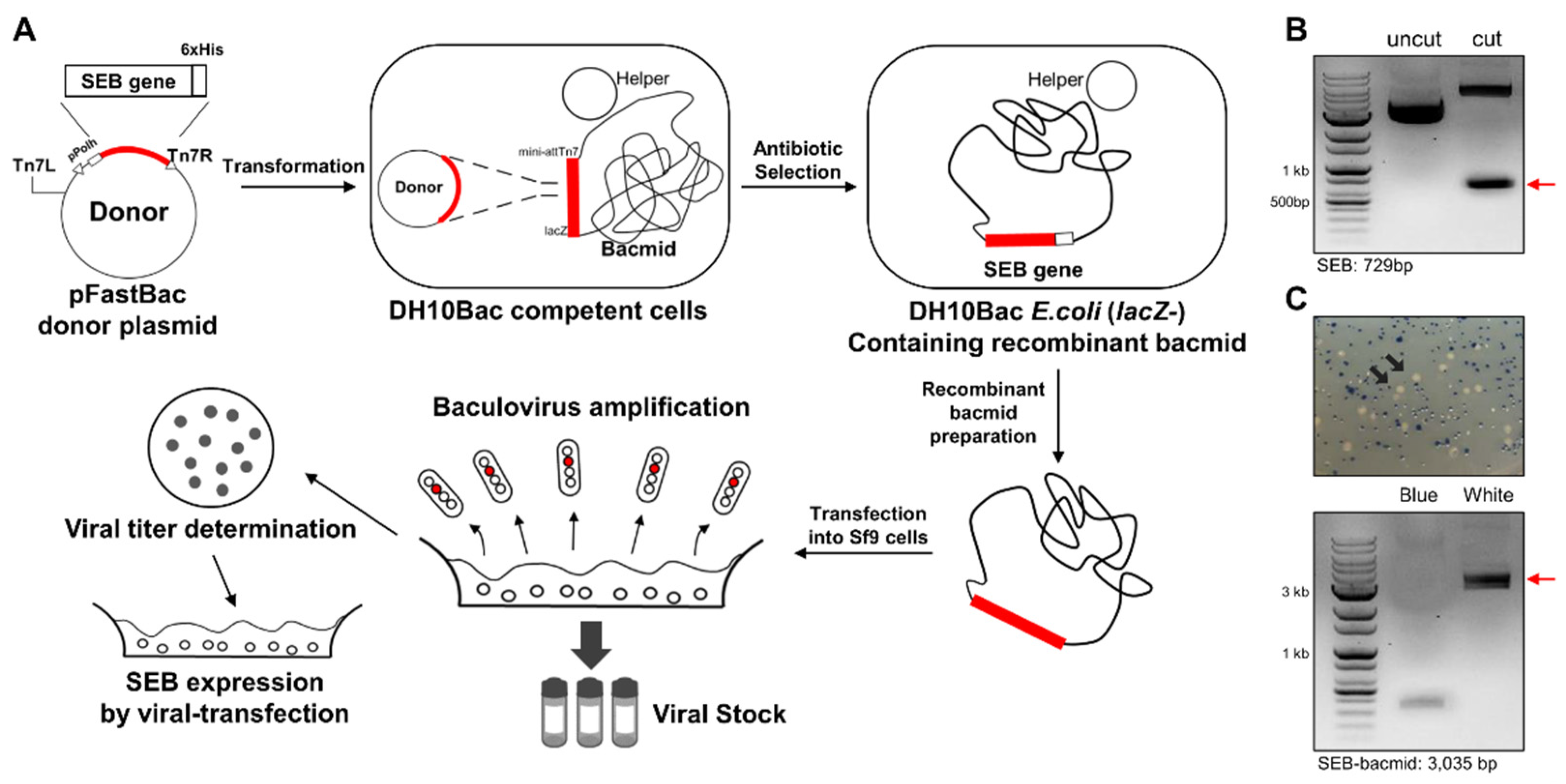
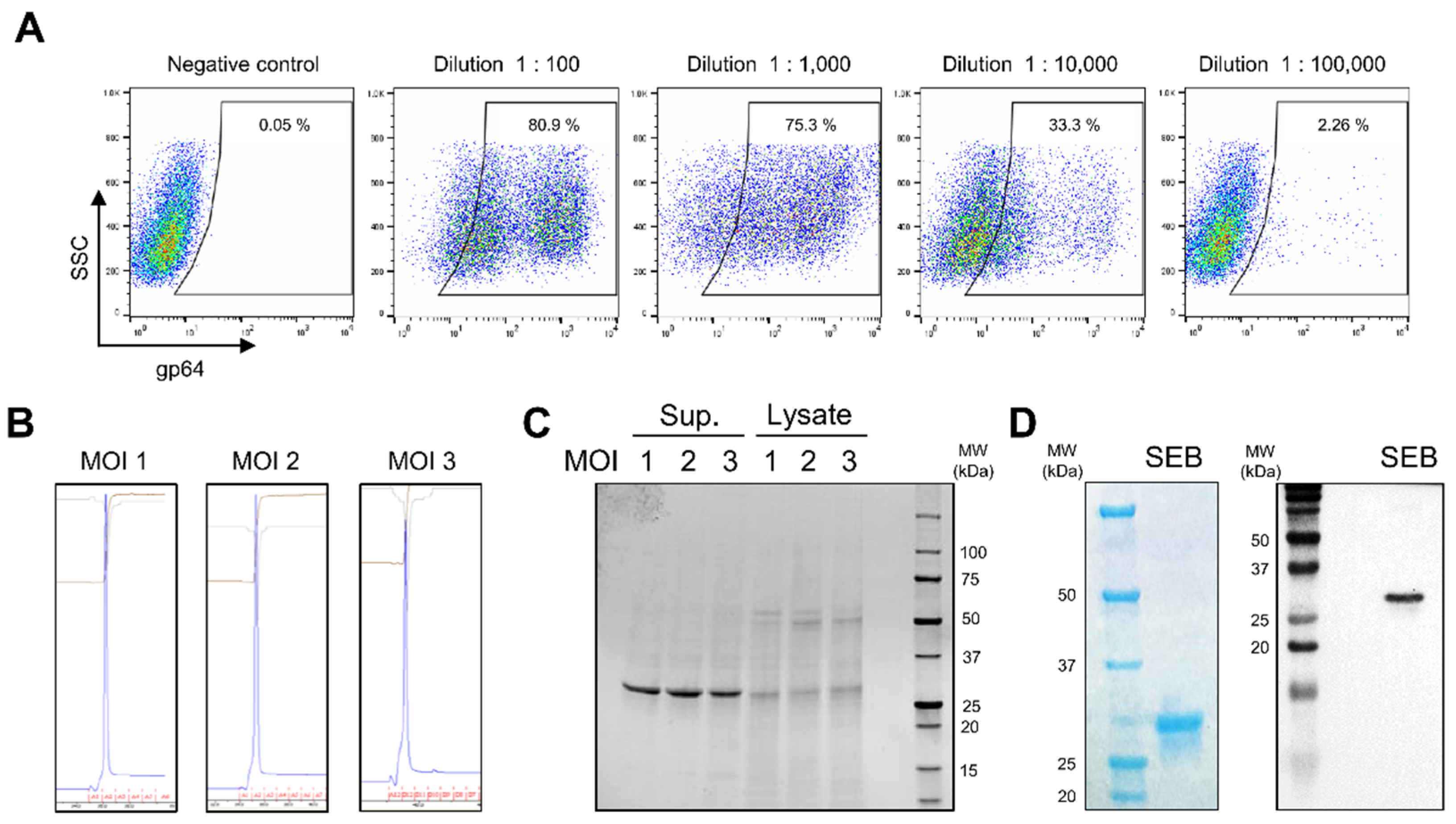
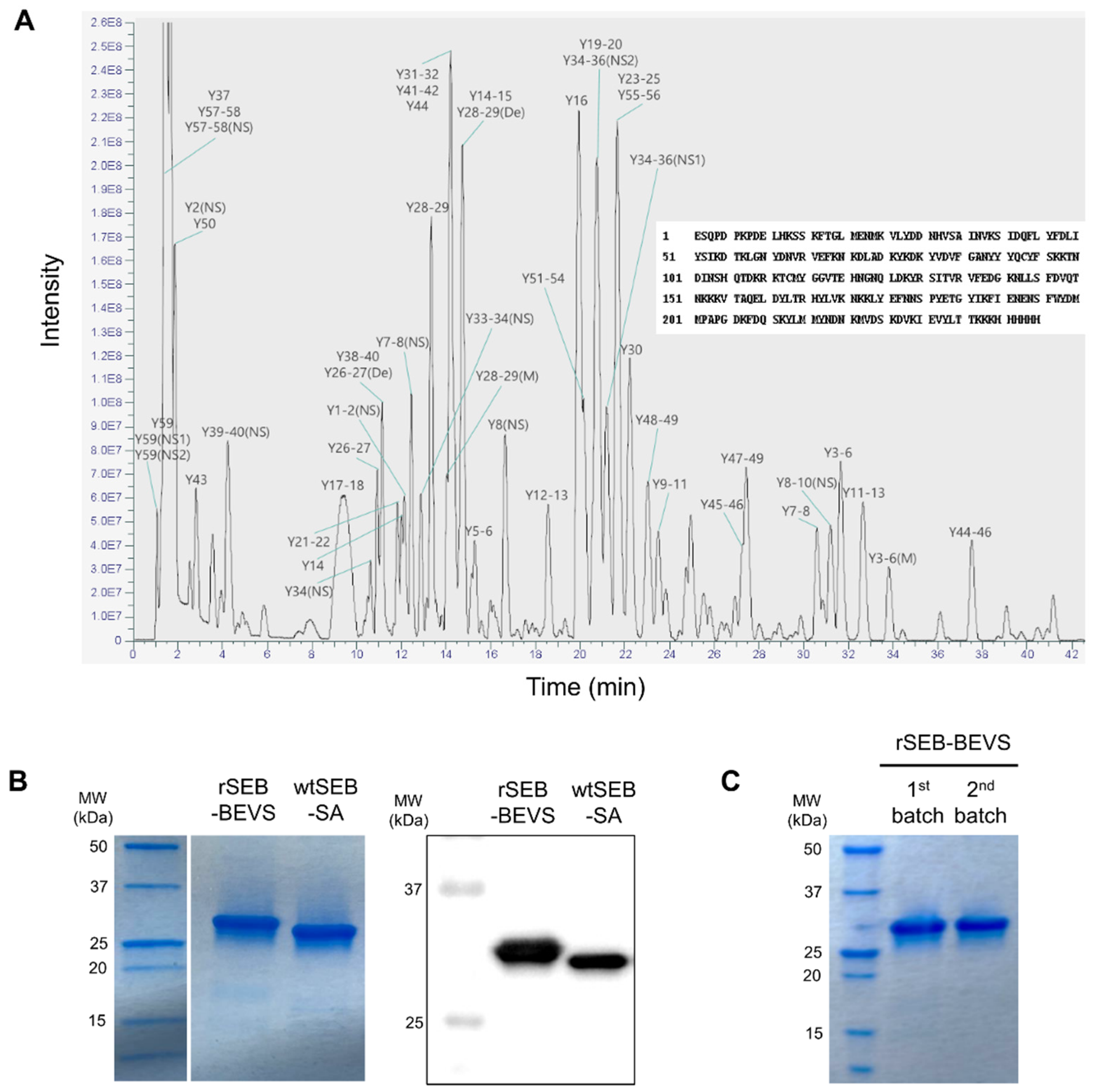
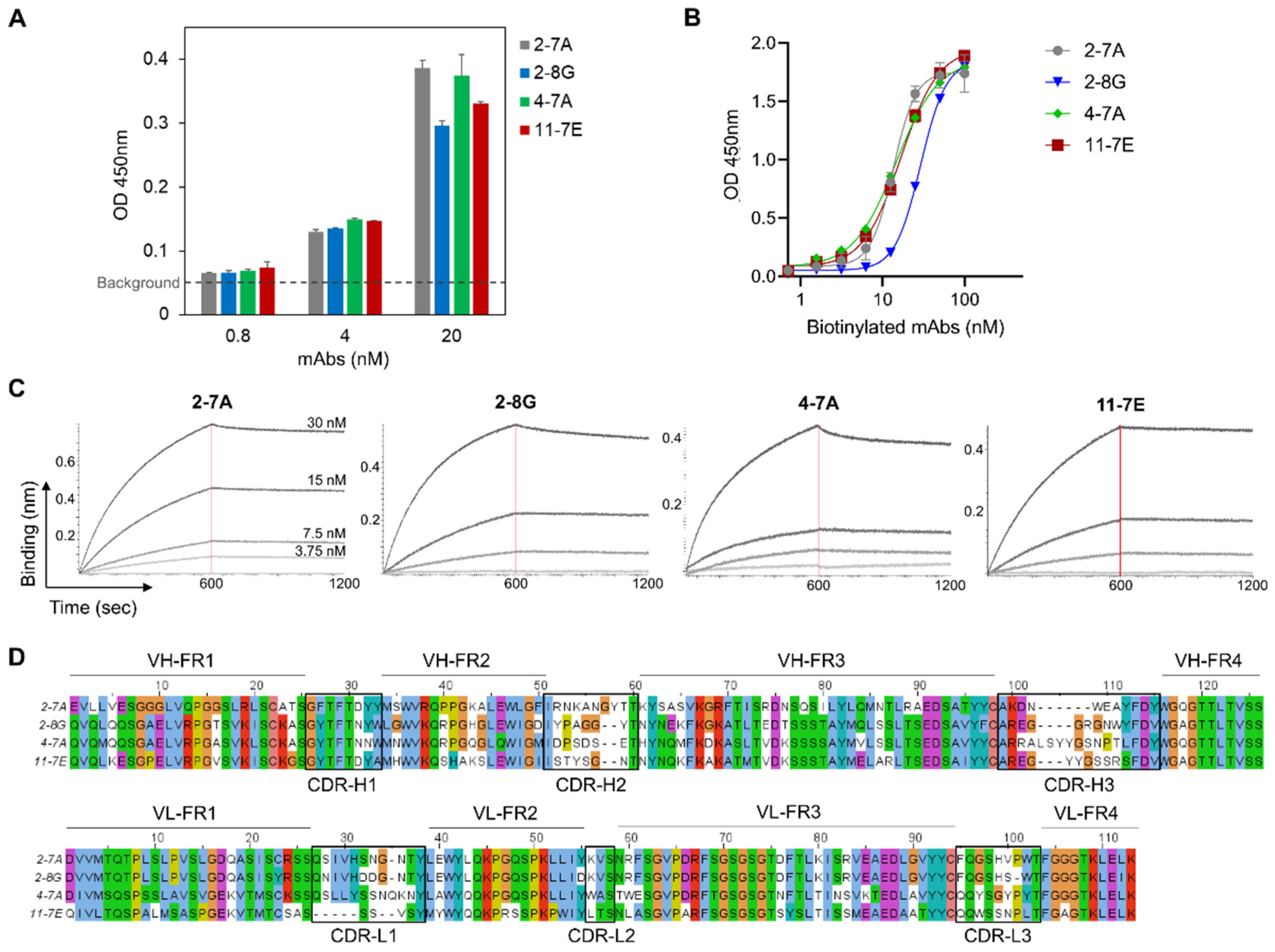
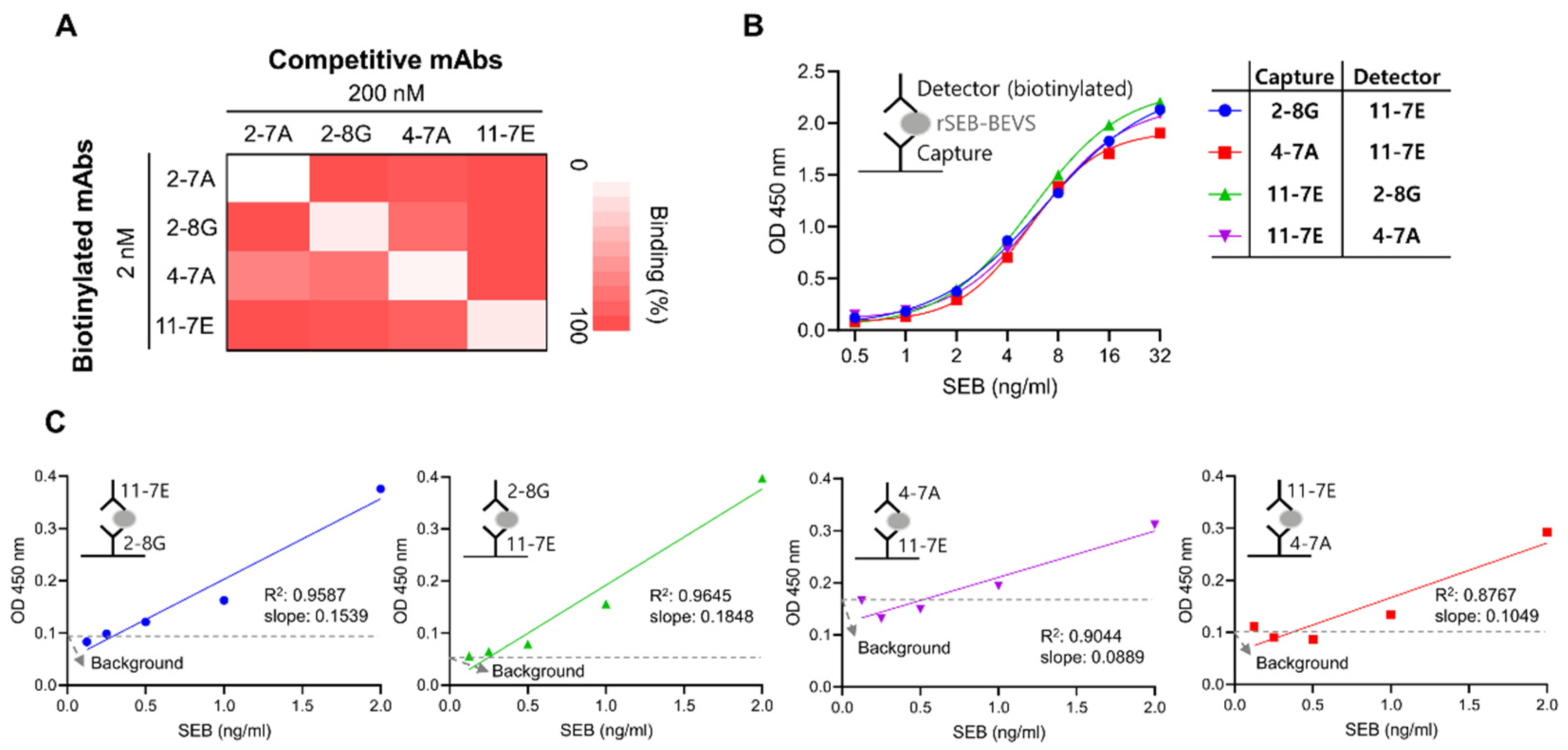
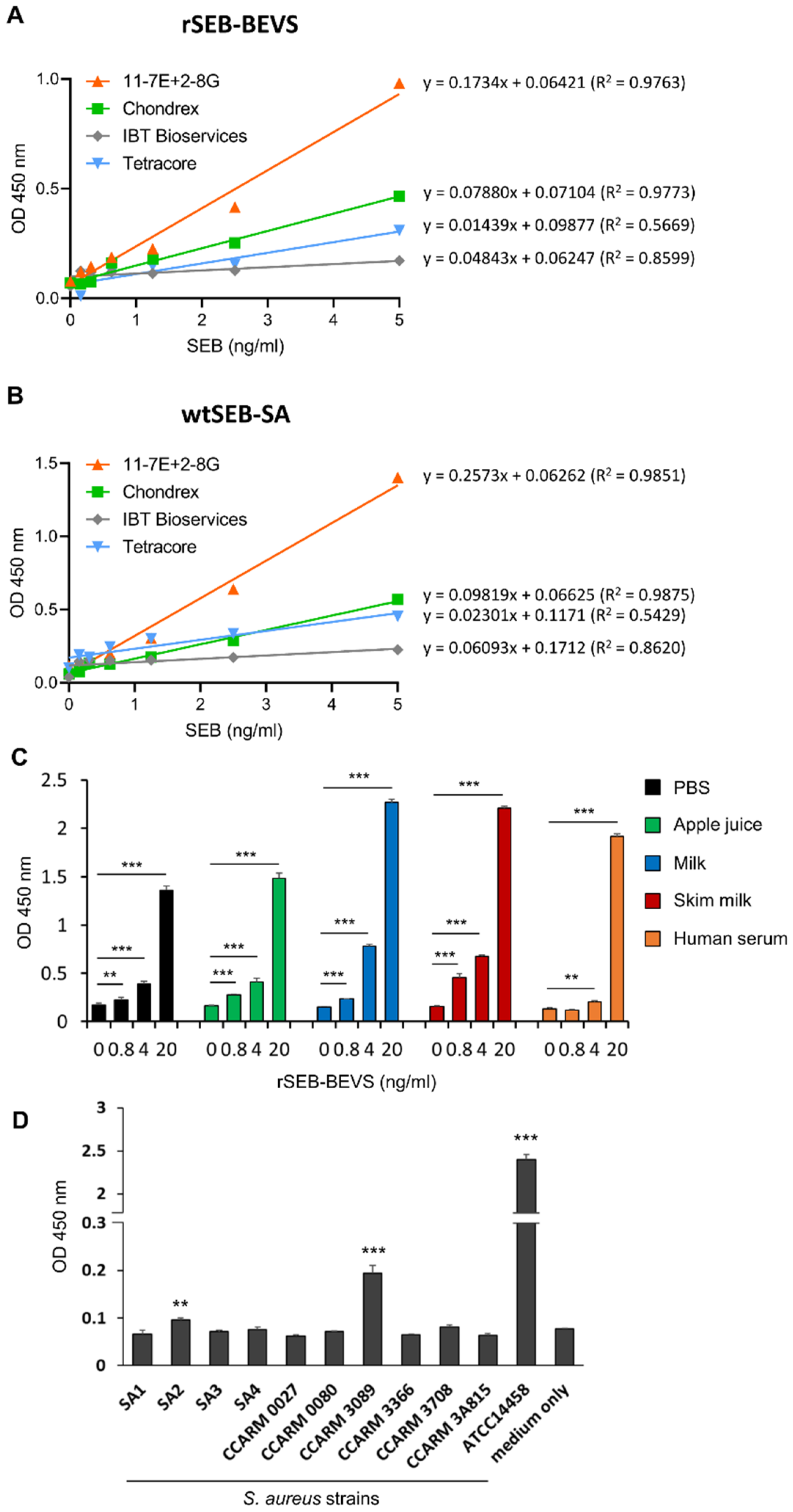

| Multiplicity of Infection (MOI) | 1 | 2 | 3 |
|---|---|---|---|
| Viral titer (ivp/mL) | 0.5 × 107 | 1.0 × 108 | 1.5 × 108 |
| Supernatant (mg) | 3.15 | 4.2 | 2.4 |
| Yield (mg/L) | 105 | 140 | 80 |
| mAb | KD (M) | Kon (1/Ms) | Koff (1/s) | R2 |
|---|---|---|---|---|
| 2-7A | 5.50 × 10−10 | 1.28 × 105 | 7.02 × 10−5 | 0.9995 |
| 2-8G | 8.26 × 10−10 | 1.54 × 105 | 1.27 × 10−4 | 0.9996 |
| 4-7A | 1.55 × 10−9 | 1.46 × 105 | 2.26 × 10−4 | 0.997 |
| 11-7E | 3.31 × 10−10 | 9.90 × 104 | 3.27 × 10−5 | 0.9998 |
Publisher’s Note: MDPI stays neutral with regard to jurisdictional claims in published maps and institutional affiliations. |
© 2022 by the authors. Licensee MDPI, Basel, Switzerland. This article is an open access article distributed under the terms and conditions of the Creative Commons Attribution (CC BY) license (https://creativecommons.org/licenses/by/4.0/).
Share and Cite
Jang, J.-H.; Kim, S.; Kim, S.-G.; Lee, J.; Lee, D.-G.; Jang, J.; Jeong, Y.-S.; Song, D.-H.; Min, J.-K.; Park, J.-G.; et al. A Sensitive Immunodetection Assay Using Antibodies Specific to Staphylococcal Enterotoxin B Produced by Baculovirus Expression. Biosensors 2022, 12, 787. https://doi.org/10.3390/bios12100787
Jang J-H, Kim S, Kim S-G, Lee J, Lee D-G, Jang J, Jeong Y-S, Song D-H, Min J-K, Park J-G, et al. A Sensitive Immunodetection Assay Using Antibodies Specific to Staphylococcal Enterotoxin B Produced by Baculovirus Expression. Biosensors. 2022; 12(10):787. https://doi.org/10.3390/bios12100787
Chicago/Turabian StyleJang, Ju-Hong, Sungsik Kim, Seul-Gi Kim, Jaemin Lee, Dong-Gwang Lee, Jieun Jang, Young-Su Jeong, Dong-Hyun Song, Jeong-Ki Min, Jong-Gil Park, and et al. 2022. "A Sensitive Immunodetection Assay Using Antibodies Specific to Staphylococcal Enterotoxin B Produced by Baculovirus Expression" Biosensors 12, no. 10: 787. https://doi.org/10.3390/bios12100787
APA StyleJang, J.-H., Kim, S., Kim, S.-G., Lee, J., Lee, D.-G., Jang, J., Jeong, Y.-S., Song, D.-H., Min, J.-K., Park, J.-G., Lee, M.-S., Han, B.-S., Son, J.-S., Lee, J., & Lee, N.-K. (2022). A Sensitive Immunodetection Assay Using Antibodies Specific to Staphylococcal Enterotoxin B Produced by Baculovirus Expression. Biosensors, 12(10), 787. https://doi.org/10.3390/bios12100787





